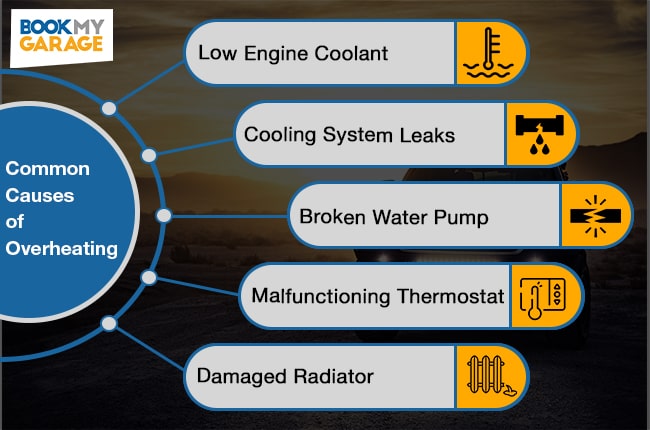If your car is overheating, then you won't get far before you cause irrevocable engine damage.
Read on and find out how long you can keeping driving an overheating car, what to do when your car overheats, and what could be causing the problem.
Page Contents
How Far Can You Drive an Overheating Car?
The furthest you can drive an overheating car is about a ¼ mile before you risk irreversible engine damage.
While some vehicles could still make it as far as 20 miles, we would never recommend driving very far with an overheating engine.
Continuing to drive an overheating car can lead to costly repairs and possibly even complete engine failure.
What Should I Do When My Car Overheats?
If your car overheats when you're driving, pull over safely and turn off the engine.
Give the car enough time to cool down completely before you check the coolant level - ideally an hour or two.
If your coolant levels are low, then a leak may be present.
Look underneath the car for any puddles or dripping fluid to try and work this out.
Do not open the radiator cap whilst the engine is hot - pressurised steam could escape and burn you.
If you can't locate the issue yourself, call for roadside assistance or a tow truck and have your car taken to a professional mechanic for a repair.
Why Is My Car Overheating?

There are several problems that can cause a car to overheat.
Low Engine Coolant
Your vehicle’s cooling system relies on antifreeze to keep the engine cool.
When the amount of coolant is inadequate, it’s not efficient at absorbing the heat, so it may boil over.
The engine temperature will increase, and this can even lead to the engine seizing or locking.
Cooling System Leaks
Coolant is supposed to remain at the same level in a properly functioning vehicle.
However, cracked, damaged, worn out, or loose hoses could be causing coolant leaks.
Hence, the coolant will not flow to the intended parts causing the car to overheat.
Puddles under the car that appear orange, green, or blue often indicate leaking coolant.
If you see any of these as you go about your car maintenance routine, don’t ignore them.
Book an appointment at a local garage to get the problem fixed.
Broken Water Pump
Coolant is a mix of antifreeze and water.
A water pump drives the coolant into the various engine components.
Therefore, it will not supply the engine with sufficient coolant to keep it running at optimal temperatures when it’s broken or damaged.
Malfunctioning Thermostat
Another common reason for an overheating engine is a bad thermostat.
A thermostat regulates the coolant, which keeps the engine from overheating.
Thermostat failure causes irregular temperature readings, preventing coolant from flowing as intended.
This leads to an unwanted temperature increase.
Damaged Radiator
The radiator decreases coolant temperature enabling it to keep absorbing heat.
Hence, when it has issues, it will keep the coolant warm and reduce the coolant’s capability of cooling the engine.
What Happens If You Keep Driving a Car That’s Overheating?
Modern internal combustion engines produce lots of heat to keep the car running.
The coolant or antifreeze absorbs the heat.
When your cooling system is not working correctly, your engine will keep overheating until you get it fixed.
What’s more, driving an overheating vehicle can cause all sorts of problems.
A Damaged Radiator
Suppose your vehicle still has coolant in it when it’s overheating.
In that case, the antifreeze will boil and expand, causing excess pressure in the radiator hoses.
The hoses may end up bursting, and all that coolant will spill over.
In addition, you may end up with failed radiator stems.
Warped Engine Parts
Most engine parts can handle high temperatures, but they will start to warp when they exceed this maximum temperature.
For example, cylinder heads are made of aluminum which can melt quickly in high temperatures.
Warped cylinder heads could lead to a blown head gasket, one of the most expensive car repairs.
Signs You Have Warped Cylinder Heads
Any of the following symptoms could indicate your cylinder heads have warped:
- Misfiring
- Decreased engine power
- Oil leaks
- Excessive oil burning
The electrical wiring, welds, sensors, seals, pistons, cranks, and camshafts can all also warp and lead to an expensive repair.
Blown Head Gasket
After a warped cylinder head, the next thing that you’ll deal with is a blown head gasket.
Repairing a blown head gasket is both expensive and labor-intensive.
Since its job is to seal the cylinder’s firing pressure when a head gasket blows, the coolant and engine oil will leak into the cylinders.
Signs You Have a Blown Head Gasket
Any of the following warning signs can signal that your head gasket has blown:
- White exhaust smoke
- Unexplained antifreeze loss without any leaks
- Bubbling in the coolant reservoir + radiator
- Milky white tint in the oil
How Long Can a Car Overheat Before Suffering Damage?
It’s risky to keep driving a car that’s overheating.
As we’ve mentioned, your car may manage to go a couple of miles.
Still, in most cases, the vehicle will stop running when the temperature reaches its maximum.
When a car overheats, the best course of action is to pull over at a safe location, turn off the engine, and have the vehicle towed to a local garage.
How Do I Know If My Engine Is Damaged from Overheating?
Unfortunately, overheating is not one of those problems that you can ignore and hope that it goes away.
It’s a matter of time, but your engine will suffer damage.
The following warning signs can indicate that your vehicle has suffered engine damage from overheating.
Ticking Sounds
Ticking sounds mean that there’s not enough oil to lubricate the parts.
This is often due to overheating since the oil loses its lubricating power in high temperatures and instead acts like water.
Therefore, the engine parts will scrape against each other, causing the ticking sounds.
Engine Detonation
An engine detonation, also known as engine knock, happens when fuel combusts before reaching its maximum combustion state.
Thus, the amount of energy you receive from the gas is minor, and your fuel economy will suffer.
If you notice power loss accompanied by low MPG (miles per gallon), your engine is probably damaged from overheating.
Scuffed Pistons
Metal parts expand in high temperatures.
Pistons in the engine are the common culprits of expansion.
When they expand, they will start to touch the walls of the engine, resulting in scuffing.
You will see scratched patches on the wrist pins and the piston ring lands.
Scuffing leads to piston failure since the edges wear down.
In addition, gasoline may also move past the pistons increasing the risk of further damage.
That’s why scuffed pistons are one of the most critical signs of a damaged engine.
Blown Head Gasket
Perhaps the surest sign that your engine is damaged from overheating is a blown head gasket.
Since it’s expensive to repair a blown head gasket, always ensure that the cooling system is working correctly.
Cracked Engine Block
A cracked engine block is far worse than a blown head gasket or warped cylinder head because it means your vehicle needs a new engine.
Fortunately, it’s a rare occurrence that only happens if you ignore all the other signs of overheating.
Nevertheless, it’s difficult to diagnose a cracked engine block since it presents similar signs to those of a blown head gasket or warped cylinder blocks.
If you suspect that your vehicle has suffered engine damage, be sure to book a repair at a professional garage as soon as possible.








10 replies to "How Far Can You Drive an Overheating Car?"
Derik
December 29th, 2023
Eve McPherson
January 3rd, 2024
kelvin
September 8th, 2022
Drew Hickman
September 9th, 2022
Justin
September 9th, 2022
Drew Hickman
September 12th, 2022
Andrea Moore
December 1st, 2022
Drew Hickman
December 2nd, 2022
Thomas
December 24th, 2022
Drew Hickman
January 3rd, 2023
Leave a comment